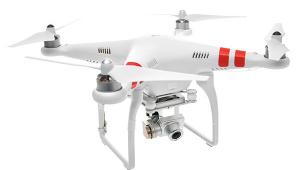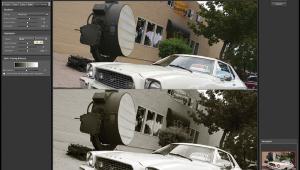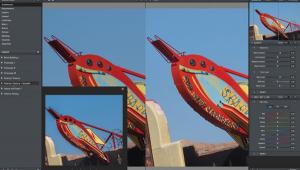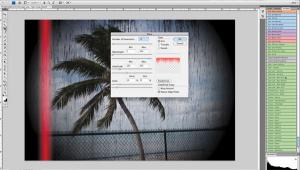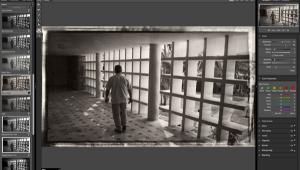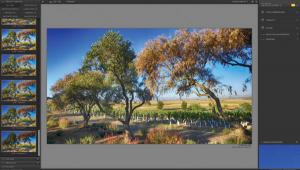Digital Innovations
Share & Share Alike; Photo Sharing Is A Good Thing Page 2
Blue Screen Portraits II: The Sequel

Digital Anarchy's Primatte 2.0 takes a foreground image of any resolution, shot against a single color, and replaces that color with transparent pixels, letting you create a soft-edged mask. This gives you the flexibility to add any custom background that you or your client wants to see...after the photo shoot. In this case, Mary's original portrait was made in our kitchen using natural light and Photoflex's (www.photoflex.com) blue screen FlexDrop.

The plug-in will create masks around areas of complex detail that are usually
difficult to retain, like wisps of hair, glass surfaces, smoke, and water. Primatte's
tools are easy to use. Just click-and-drag to define the tonal values that you
want
to extract.

Primatte uses sophisticated algorithms to extract the background color. These algorithms also help you to color correct your subject, removing any color cast that might be caused by the original blue or green background. Here Mary is composited onto a landscape photograph.
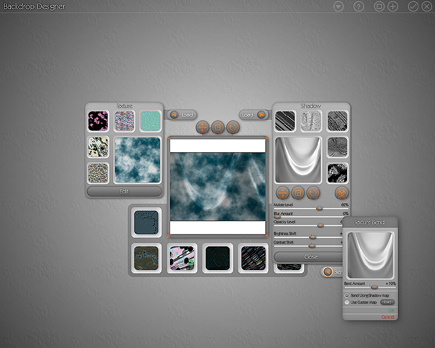
Digital Anarchy's Backdrop Designer plug-in creates resolution-independent backdrops, similar to those muslin backgrounds hanging in your photography studio. It will create a patterned background of any size and resolution. Start by picking a Texture from an infinite variation of colors and patterns, and then adding a Shadow preset to simulate shadows and distortions, like drapery folds.
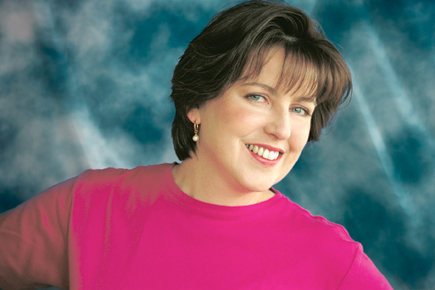
You can customize the built-in presets with color sliders and opacity overlays and produce random variations of your composite to create slightly different visual options. Then save your new pattern and apply the digital backdrop to your photograph. Yup, it's that easy.
The Return Of Godzilla
In September 1998 I wrote a story for Shutterbug called "Digital Compositing:
Creating Blue Screen Portraits." Check the stacks next to your old National
Geographics. I used a Photoshop compatible plug-in called Primatte to make a
composite picture of my wife, Mary, being attacked by a Godzilla-like lizard.
It was a great plug-in for blue screen compositing but had an interface only
a geek could love. Now Primatte 2.0 offers a slick, easy to use interface that
makes creating masks of complex foreground objects, including wispy hair and
even smoke.
Digital Anarchy's (www.digitalanarchy.com)
Primatte 2.0's blue and green screen masking technology, known as chromakeying,
extracts a single color background from an image to create a transparency mask.
While blue and green are the most common colors used for backgrounds, Primatte
can use almost any color. Masked objects are created on their own layer, making
it simple to composite the result with any other layer or apply additional background
effects. The dialog box previews Photoshop layers as a background, thus allowing
real-time adjustments. Single-click tools let you eliminate color from transparent
or opaque areas with color reflected from the background. Available for both
the Mac OS and Windows, Primatte costs less than $300.
But wait, there's more. While you can always use different images from
your files as a backdrop, Digital Anarchy's Backdrop Designer lets you
create wholly digital ones. This Photoshop compatible plug-in creates beautiful
resolution-independent backgrounds, very similar to those expensive muslin drapes
you may currently have in your studio.
You can choose from hundreds of presets, or customize your own by using Digital
Anarchy's "Pattern Generation" process at any size and resolution.
Backdrop Designer costs less than $200.
 LumiQuest
Software?
LumiQuest
Software?
LumiQuest's (www.lumiquest.com)
Ultra Image is a package of Photoshop Actions that automate what you can do
in Adobe Photoshop if you knew how. The Actions use core technologies of Photoshop
and work with Photoshop 6, 7, and CS on either the Mac OS or Windows, but not
Photoshop Elements or any other image-editing program. The most interesting
aspect of Ultra Image is that you order a package based on the digital camera
you're using. About 90 percent of Ultra Image is the same for all cameras,
but the customization ensures that color and noise characteristics of specific
cameras are taken into consideration. You can use the Actions in any file format,
as long as they are RGB. Ultra Image costs less than $60 and gives newbies recipes
for advanced image processing. Experienced users will benefit from having this
easily customizable suite of Actions.
- Log in or register to post comments
